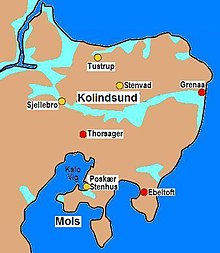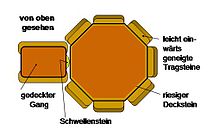Dolmen in the Balle Mark
The dolmen in Balle Mark are located in a field north of Balle in Djursland in Denmark .
Dolmen 1
The complete polygonal pole is located in a round hill that was originally set with curbs. It is a megalithic system of the Neolithic Funnel Beaker Culture (TBK) that dates from 3500 to 2800 BC. Was built. Neolithic monuments are an expression of the culture and ideology of Neolithic societies. Their origin and function are considered to be the hallmarks of social development.
The narrow and low corridor consists of two pairs of bearing stones and is covered with two cap stones. At the transition between the chamber and the aisle there is a double lintel that distributes the pressure of the single capstone weighing 12 to 15 tons. The small, almost round chamber measures 2.0 × 1.8 m and is 1.7 m high. It consists of five supporting stones between which, in several places, a dry masonry made of flat plates is inserted. The stones face the chamber with their flat side and form a hexagonal space with the passage .
There were no archaeological excavations. The hill was placed under protection in 1887. In the Stone Age there was a narrow five kilometer long fjord of the Kattegat nearby, which was drained by the uplift . The Runddysse is now about 12 m above sea level.
Dolmen 2
In the Balle Mark a 1.5 m high round mound with a diameter of about 12.0 m with 23 preserved curbs was excavated in the 1880s. In the center of the hill was a slightly recessed polygonal pole of the TBK.
The approximately southeast-northwest oriented chamber has a hexagonal floor plan. It has a diameter of about 2.8 m, which is why K. Ebbesen speaks of a "Stordysse" (which does not correspond to the German designation large dolmen ). At 1.8 m high, it is unusually high and consists of 5 supporting stones (plus the 0.7 m wide access with threshold stone ). The 5 bearing stones, between which there is dry masonry , are inclined inwards in the manner characteristic of the type. The corridor, made up of 6 bearing stones and intermediate masonry, is about 3.6 m long, 0.65 m wide and 1.3 m high.
The finds consist of skeleton parts, 4 flint daggers , 3 cuts, 2 chisels, 1 thin-bladed ax, all made of flint and various shards.
See also
literature
- Jakob Vedsted: Fortidsminder og Kulturlandskab. En kildekritisk analysis af tragtbaegerkulturens found material from Norddjursland. Forlaget Skippershoved, Ebeltoft 1986, ISBN 87-981329-5-4 .
- Jürgen E. Walkowitz: The megalithic syndrome. European cult sites of the Stone Age (= contributions to the prehistory and early history of Central Europe. Vol. 36). Beier & Beran, Langenweißbach 2003, ISBN 3-930036-70-3 .
Individual evidence
- ^ Johannes Müller : Neolithic Monuments and Neolithic Societies. In: Hans-Jürgen Beier , Erich Claßen, Thomas Doppler, Britta Ramminger (eds.): Varia neolithica VI. Neolithic Monuments and Neolithic Societies. Contributions from the meeting of the Neolithic Working Group during the annual meeting of the North-West German Association for Ancient Research in Schleswig, 9. – 10. October 2007 (= contributions to the prehistory and early history of Central Europe. Vol. 56). Beier & Beran, Langenweißbach 2009, ISBN 978-3-941171-28-2 , pp. 7-16, here p. 15.
Web links
Coordinates: 56 ° 19 ′ 20 ″ N , 10 ° 48 ′ 32.9 ″ E

